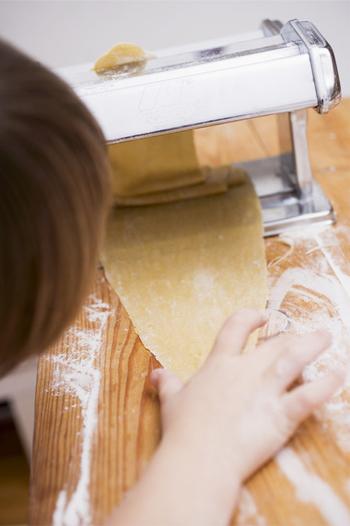Making pasta
Duration/age

Work with your child and look for a recipe to make pasta dough. Once you’ve found a recipe talk with your child about the different steps you will do to make the dough. If the recipe has pictures point to each one and explain what is happening.
First we’ll sieve the flour. Then we’ll mix in the eggs and last we will knead the dough.
After the dough has rested we can roll out the dough - stretching so it gets thinner and thinner.
Talk to your child about how you will stretch the dough to make it long and thin.
First we will roll the dough with a rolling pin. Then we’ll pass it through the pasta machine.
As the dough gets thinner we can turn down the setting on the machine to move the rollers closer together.
Let your child help you pass the dough into the machine. As they turn the handle get them to check and see if the dough is getting fatter or thinner. Talk about how many times you will have to pass the dough through before you can change the setting on the machine.
The dough is thin enough now to cut into ribbons. We can change the setting to cut the dough into long thin strips.
When you have finished cutting the dough hang the ribbons over a broom handle to dry.
Materials you will need
- Rolling pin
- Fork
- Broom handle
- Flour, eggs, salt
- Mixing bowl
- Pasta machine
- Sieve
Alternative tools
- Whisk
- A stick
Skills this activity improves
Why does this matter?
When your child helps you to make pasta they are exploring the different ways that we measure and use language to describe what we see and do.
As they help to make and roll out the dough they are learning to follow instructions and to plan and sequence what to do next.
What does this lead to?
Following instructions and being shown the order to complete a task helps children to plan and organise their time. As they explore how to order and plan what they’re doing they are developing problem-solving and planning skills. Developing planning skills supports children to be efficient and to not waste time and resources because they have to re-do a job.
Making pasta helps children explore the different ways that we measure and use language to describe it. As they make the pasta they will be exploring:
- time - how long it will take to knead the dough
- size - how long or thick the dough will be
- temperature - how hot the water needs to be before the pasta goes in
Language to use
- Flour, eggs, salt, water
- Mixing bowl, whisk, fork, rolling pin, pasta machine
- Mixing, kneading, rolling, stretching, cutting, sieve
- Dough, sheets of pasta, ribbons of pasta, strips of pasta
- Cook, dry, freeze, boil
- Liquid, solid
Questions to use
- How thin do we need to roll the dough?
- Where do we crack the eggs?
- How long can we roll the dough?
- How thin can we roll the dough?
- Which dough will cook faster - the thick or thin dough?
Useful tips
- Turing the handle on the pasta machine can be very heavy work when the pasta is thick. Maybe get your child to help once the dough is a little thinner.
- Stick a measuring tape to the bench. See if you can you stretch the dough out as long as the tape.
- You might like to take a look at this more detailed guide to making basic pasta dough or look online for one that suits you.
- Remember to talk to your child in your home language.
More ideas
- Practise rolling out playdough before starting on the pasta dough.
- Make pasta in different shapes.
- Make scones so you can practice mixing dough.
Variation by age
Three to five year olds
- Explore the different shapes and sizes of pasta at the supermarket.
- Set up a clothesline to dry the pasta on.
- Draw shapes on paper and see if you can twirl the pasta to fit the shapes.
Questions to ask
- What different shapes can you see?
- Is all pasta the same size?
- Will it take longer to cook ribbon pasta or ear-shaped pasta?
Language to use
- Shape, ribbon, wheel, spiral, curly
- Orecchiette, fettuccine, spaghetti, fusilli, ravioli
- Thick, thin, flat
- Time, length


